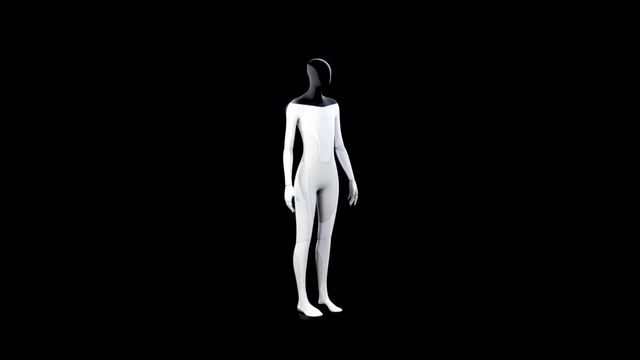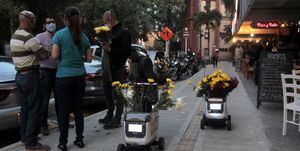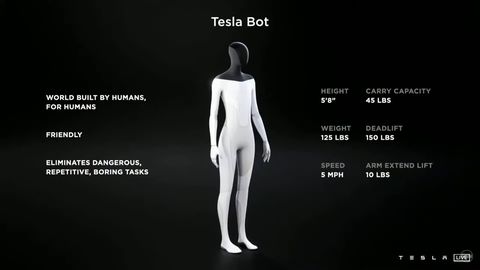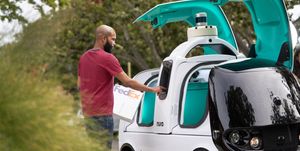At the end of Tesla’s eagerly awaited AI Day, CEO Elon Musk revealed that the automaker is working on a humanoid robot, promising a prototype sometime in 2022. The planned robot, as the company envisions it, will be meant for repetitive physical tasks, and will have a screen for a face. The robot will stand five feet and eight inches tall and weight 125 pounds, the company indicated, and will be “friendly.” Tesla said that the humanoid robot will feature 40 electromechanical actuators, and use lightweight materials in its construction.
Tesla aims to use a version of its Autopilot cameras and an FSD computer to operate the robot, effectively using the Level 2 semi-autonomous driving tech, while also offering a carrying capacity of 45 pounds. The robot is also planned to have a top speed of 5 mph, with the company planning to show a prototype dubbed Tesla Bot in 2022.
Among other things, Musk cited an example of grocery shopping among the things the robot—which the company plans to call Optimus—could eventually do for people. At least in theory. Musk also cautioned that the robot “probably won’t work” initially.
The Tesla robot was previewed by a human in a tight-fitting suit, who walked up on the stage during the presentation in a stilted manner, mimicking a robot, and then proceeded to perform a short dance routine.
Tesla won’t be the first automaker to attempt to build a humanoid robot, as Honda had created a series of ASIMO robots starting in the year 2000, though development began in the 1980s. Honda’s ASIMO, which stands for Advanced Step in Innovative Mobility, is four feet and three inches tall, and weighs 119 pounds. The software that controls the robot has obviously evolved over time, allowing it to respond to voice commands and gestures, as well as recognize objects around it.
ASIMO achieved TV commercial success, if not commercial success.
Boston Dynamics, which is now majority-owned by Hyundai, has been working on humanoid robots for quite a while now, if not as long as Honda, and despite the development time spent, the company is not promising a commercial humanoid robot in 2022. Its humanoid robots, which are widely regarded as the most sophisticated in the industry and can perform various acrobatic tasks, including parkour, are not believed to be close to a commercial launch, even though the company has attempted to market other robots.
Incidentally, one of the technical challenges holding back most robots at the moment is battery technology, which does not permit very long operating times, so this is one area in which Tesla could help achieve a breakthrough given its work on battery tech.
Boston Dynamics’ dog-like Spot robot, available commercially, can function for about 90 minutes. Obviously, humanoid robots tend to have larger battery packs than the dog-sized Spot, but they also have greater weight and movement requirements when it comes to electrical power needed. So the software needed to make robots perform tasks, such as replacing human employees in a car factory, is not the biggest technological barrier at the moment.
Boston Dynamics’ Atlas, which is one of the company’s humanoid robots, is powered by a 3.7-kWh lithium-ion battery, which buys it about an hour of operating time. Of course, battery time varies by how much work it’s required to do, so if it stands still or walks only a little it can stretch that time out. But it’s safe to say that performing acrobatic tasks for a filmed video in a scripted environment and actually being useful in real-world applications are two different things, even if battery life was not an issue.
Curiously, Tesla has stayed out of delivery robot development, which is an emerging industry that has invited plenty of attention following the start of the pandemic, despite already fielding semi-autonomous technology and battery technology. Tesla had promised that robo-taxi technology would arrive in its cars by the end of 2020, but has not given an update on that past forecast.
It remains to be seen whether Tesla’s robot plans will be taken seriously by the financial markets—used to creating forecasts based on microanalysis of Elon Musk’s and Tesla’s statements while taking them at face value.
Should more automakers work on humanoid robots, or is this a commercial dead-end when it comes to profit? Let us know in the comments below.
Source: Read Full Article





